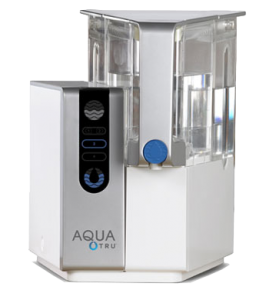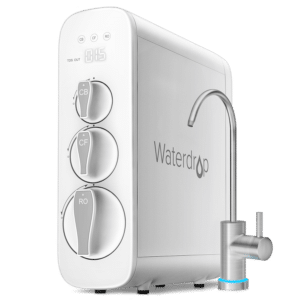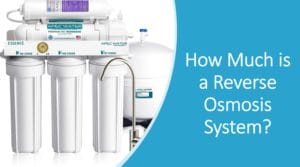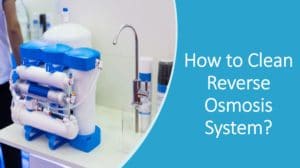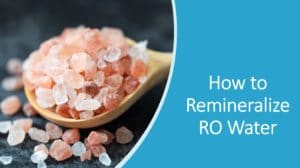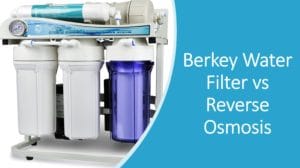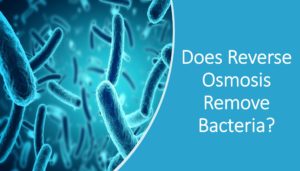Reverse Osmosis (RO) water systems provide some of the cleanest, excellent-tasting water. These systems are efficient and safe, fully-automated and priced reasonably.
From our research, the best reverse osmosis system is Waterdrop WD-G3, a powerful, NSF-certified under-sink reverse osmosis filter with innovative features, a sleek, compact design, and plenty of purified water.
Continue reading to learn more about reverse osmosis systems and how to choose the right one.
Our Top Picks
- Best Overall: Waterdrop Reverse Osmosis System
- Best Countertop Style: Aquatru Reverse Osmosis Water System:
- Best Commercial Reverse Osmosis: Defender Whole House Commercial Filter
- Runner Up Tankless System: NuAqua Tankless Reverse Osmosis System
- Best Traditional RO System: Softpro Green RO System
There are several reasons to choose a reverse osmosis system for your water filtration needs.
Easy to Maintain:
Reverse Osmosis filtration systems have efficiency in design and are simple to maintain with few replaceable or moving parts. This makes them easy to service and clean.
Improves Water’s Taste:
Reverse osmosis systems improve the appearance, taste, and odor of water by getting rid of the contaminants that cause these issues.
Eliminates Impurities:
These filtration systems eliminate pollutants such as pesticides, arsenic, nitrates, pharmaceuticals, sulfates, bacteria, fluoride, and more. The carbon filter utilized in these systems removes chloramines and chlorine as well.
Cost Saving:
Reverse Osmosis water filtration systems allow you to stop purchasing those plastic water bottles. These systems provide that “bottled-water taste” and quality water for much less money.
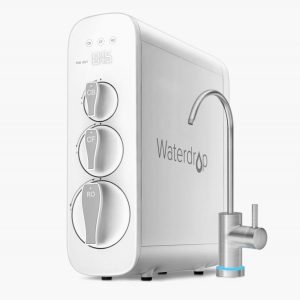
- Filter Stages: 7
- Dimensions: 18.06 x 5.68 x 17.76
- Weight: 31 lbs
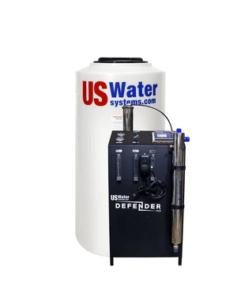
- Filter Stages: 6
- Dimensions: 29 x 29x 58 inches (140 Gallon tank)
- Weight: 300 lbs
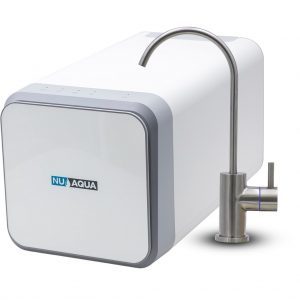
- Filter Stages: 4
- Dimensions: 27 x 16.9 x 13.7 inches
- Weight: 31.9 lbs
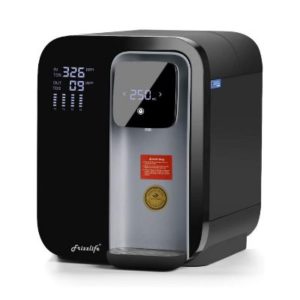
- Filter Stages: 4
- Dimensions: 10.5 x 13.2 x 13.4 inches
- Weight: 33.06 lbs
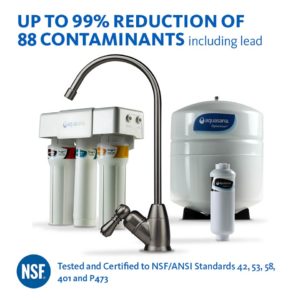
- Filter Stages: 4
- Dimensions: 12 x 4.5 x 12.5
- Weight: 12.3 lbs
Reverse Osmosis System Reviews
1. Waterdrop Reverse Osmosis Filtration System For Home
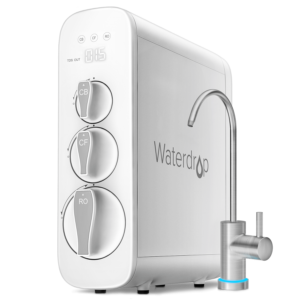
Waterdrop WD-G3 comes in seven stages which includes a sediment pre-filter containing three stages, a RO filter with three stages, and a final carbon filter with one stage. This system boasts a 0.0001µm filtration accuracy, meaning the water is almost 99% pure from fluoride, TDS, limescale, heavy metals, and other contaminants.
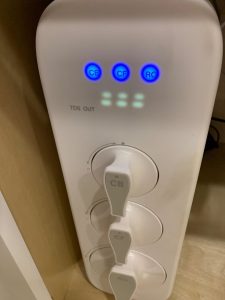
Most under-sink designs use a pressurized storage tank, but the Waterdrop features a tankless design, helping avoid secondary pollution while utilizing more space under your sink.
With an internal pump and no storage tank, this system can produce up to 400 gallons per day of filtered water, which is five times more than the average from its competitors.
In addition, the Smart LED Display ring glows with different colors to give you the status of the water filters.
The Waterdrop RO Filtration System is also considered the best reverse osmosis system for well water & has NSF 58 certification for TDS reduction and NSF 372 for lead-free material.
The installation process is easy; everything you need comes with the filter, including a quick installation guidance manual. Waterdrop offers a one-year limited warranty and excellent customer service.
- 400 gallon of water output every day
- Integrated feedback system lets you know the filter’s status
- Easiest installation of any RO system
- Sleek and slim design will save sink space
- NSF/ANSI 58 certified for TDS Reduction
- More expensive than some of its rivals
- The system cannot be placed sideways
- The water flow could be faster
2. AquaTru Reverse Osmosis Water System
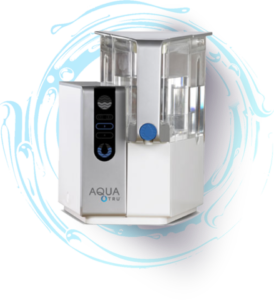
Our second choice best ro water purifer is Aquatru , an excellent choice if you’re looking for a Countertop-style RO filter. It is currently the best countertop reverse osmosis filter on the market.
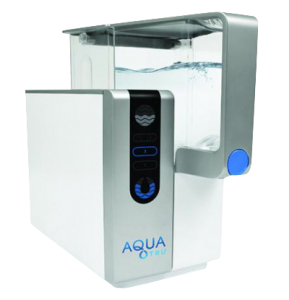
AquaTru has exploded in popularity in the past few years and for good reasons. This system gives you pure, great-tasting water with highly-effective filtration certified to NSF standards and stamped with the IAPMO Research and Testing seal of approval.
This filtration system will destroy 83 contaminants, including lead, chlorine, fluoride, nitrates, PFAs, and more.
The four-stage Ultra Reverse Osmosis process employs two pre-filters before the RO action occurs in stage three.
The RO filtration destroys toxic inorganic contaminants, including lead and chromium 6. Stage four, the Activated Coconut Shell Carbon VOC filter, eliminates toxic organic chemicals, leaving you with pure, healthy, great-tasting water.
Built with Tritan BBA and BPS-free plastic, this system is 14 x 14 x 12 inches and 16 pounds and designed to sit on your countertop. Its sleek design complements your kitchen counters. While some portable RO filters attach to your faucet, AquaTru’s system includes a one-gallon feed water tank that you will manually fill and attach to the system. In addition, the removable dispensary tank can be stored in your fridge for convenience.
This system features a 3:1 drain ratio, quick-change filters that last up 600-1200 gallons, and a digital display to alert you when the filters need replaced. You can expect ¾ gallons of water every 12 minutes.
AquaTru comes pre-assembled, taking all the work out of installation. The cost of this RO filter is higher than some, but after looking at how this powerful this system is, as well as the extra features, we believe it’s worth it. AquaTru stands behind its products and offers a one year warranty.
- NSF certified for removal of 82 contaminants
- 3:1 drain ratio (far less than standard RO systems)
- Simple installation
- Long-lasting filters
- One year warranty
- Smaller holding tank than some (one gallon)
- Plastic tank may scratch
3. Defender Whole House Commercial Reverse Osmosis Filtration
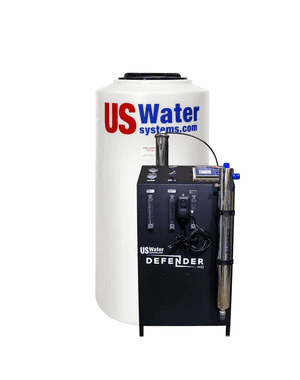
The US Water Defender Whole House RO System is an excellent choice for those interested in whole RO filtration on a large scale. This system comes with a 140 or 250-gallon atmospheric tank and a production rate of 2,000, 4,000, 6,000, or 8,000 GPD. Featuring reinforced fittings, industrial pumps, and stainless steel housing, this filter offers impressive durability.
The Defender filters arsenic, lead, PFOA, and PFOAS and is 80% efficient, wasting only one gallon per every five it produces. Its rejection rate of up to 99% is impressive.
The Multi-Stage Stainless Steel Centrifugal Pump that powers the Defender is much more durable and efficient than the typical rotary pumps used in most systems. The Defender comes with a lifetime warranty on the tank and a two-year warranty on the system components.
Our research indicates that most US Water customers find the Defender system to be highly satisfactory. Many say that they noticed an immediate difference in the taste and appearance of their water after installing the Defender.
- Low water waste
- High GPD options
- High rejection rate
- Filters up to 8,000 gallons per day
- High marks for customer service
- Lifetime warranty on tanks
- Install instructional media is not as helpful as it could be
- Checkout process on the website is glitchy
- Shipping costs are a bit high
4. NuAqua 600 GPD Tankless Reverse Osmosis System
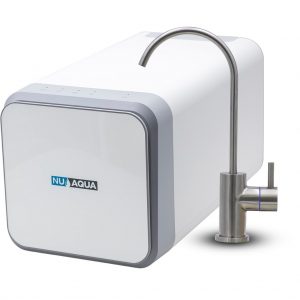
Most reverse osmosis systems take up a great deal of space. Not the Nu Aqua Tankless water filter. This compact system takes up as little as a quarter of the area that larger systems fill.
This tankless filter combines the compact convenience of a small system with the purifying power of a bulky, tanked RO machine. Nu Aqua’s four-stage water purification process results in up to 99% contamination removal.
The Nu Aqua Tankless RO System filters 600 gallons per day, producing two pure gallons for every single gallon of waste.
The filters on this system are easy to remove and replace, and the Smart Faucet features a light that indicates when filters need to be changed. An integrated booster pump makes this system ideal for houses with low water pressure.
Best of all, the Nu Aqua Tankless Ro System produces purified water much more rapidly than most larger systems used to achieve the same purification rate.
- Takes up 25%-50% of the space comparable systems use
- 600 gallons per day
- 2:1 pure to waste ratio
- Integrated booster pump allows system to work with low water pressure
- Up to 99% contamination removal
- Some users complain about after-sale support
- Difficult to install with some modern pipe systems
- Some customers report leakage
5. SoftPro GREEN RO Water Treatment System
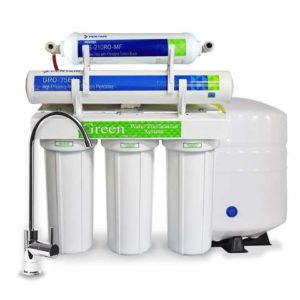
Reverse Osmosis water systems are typically very effective at filtering contaminants, but they are notorious for producing a high amount of water waste. However, that’s not always the case.
Quality Water Treatment, a family owned business since 1990, features the SoftPro Green Reverse Osmosis Water System. This system not only removes up to 96% of contaminants found in residential tap water, but it has only a 1:1 waste ratio, which is at least 2/3 less than traditional RO systems!
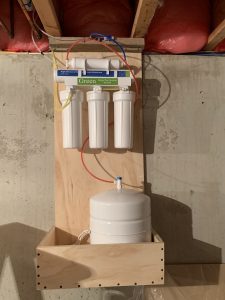
This high-efficiency system features a five-stage filtration process, starting with 5-micron sediment filtering, two coconut shell activated carbon block, a thin film RO membrane, and an activated in-line carbon post filter. QWT’s RO filter removes up to 96% of chlorine, lead, nitrates, chromium, arsenic, heavy metals, fluoride, bacteria, and viruses at a 75 gallon per day capacity. You can also purchase an optional Alkaline in-line filter that adds minerals back into your water and raises the pH level.
The SoftPro Green RO system is easy to install and comes with all you need for a successful installation. All of the fittings are “quick connect,” meaning you push them in, and they lock into place. In addition, you will get a long-reach chrome faucet to complement your filter.
However, if you do run into any issues, QWT offers excellent customer service. Seriously, this company is notorious for going above and beyond for its customers. At a great price, a 60-day money-back guarantee, and a five-year warranty, the SoftPro RO Water System is worth checking out.
- Removes 96% contaminants from tap water
- Low water waste
- Filters up to 75 gallons per day
- Affordable price
- Excellent customer service, guarantees, and warranties
- The tank is noisy when the tank refills
- Some information about this product is not found on QWT’s website
6. Aquasana OptimH2O Reverse Osmosis + Claryum System

A leader in the water filtration market and the first to create a reverse osmosis filter with remineralization technology, Aquasana features the innovative OptimH2O Reverse Osmosis System. This groundbreaking water filtration technology uses reverse osmosis and remineralization to efficiently remove fluoride plus 88 other contaminants, which they say is five times more effective than other RO systems. This system is NSF certified to standards 42, 53, 58, 401, and P473, meaning this filter has been tested to remove:
- Fluoride 95%
- Mercury 95%
- Chromium 96%
- Chlorine 97%
- Arsenic 97%
- Chloramine 97%
- Asbestos 99%
- Lead 99%
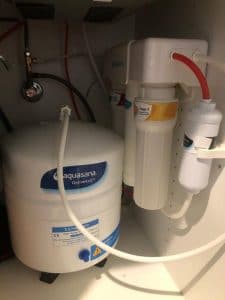
The magic happens during the OptimH2O’s five stages of filtration, including reverse osmosis, activated carbon, catalytic carbon, ion exchange, absolute sub-micron filtration, and the final stage of remineralization adds healthy minerals such as calcium, magnesium, and potassium, while maintaining optimal alkaline, pH balanced water. The reliable flow rate is 0.5 GPM (35 gallons per day), and the result is clean, purified drinking water that tastes great.
The OptimH2O comes with a metal 100% lead-free faucet in three stylish color options that will match any kitchen decor. Installing this filter is easy, especially since Aquasana provides a detailed instruction manual and three videos to guide you.
- Efficient filtering process of reverse osmosis plus remineralization
- Removes 88 contaminants, five times more than competitors
- Tested and certified to NSF/ANSI standards (very few filters have the combination of standards this one does).
- Excellent installation manual, videos, and customer service
- 90-day guarantee/two-year warranty
- Some customers report low water pressure
- The tank does not include an automatic shut-off feature for doing maintenance or making adjustments
7. SpringWell RO Water System
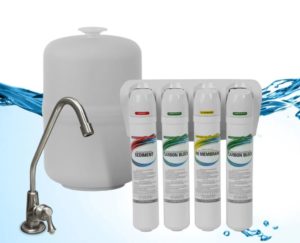
If you’re looking for a reliable water treatment system that filters water coming through your faucet, then an under-sink, Point-of-Use (POU) may be what you want. POU filters are convenient, efficient, and typically low-maintenance.
SpringWell RO Drinking System is a POU filter that removes heavy metals, such as lead, fluoride, and arsenic, from your water, leaving you with up to 75 gallons per day of clean, filtered water. This four-stage filtration process utilizes a 5-micron sediment pre-filter to remove sediment, dirt, and solid debris and a pre-filter carbon block to remove odors and objectional tastes. The third stage includes the RO membrane that removes 98% of dissolved metals, salts, and other harmful contaminants. The final stage, the post-filter carbon block, then polishes up your water by removing any tastes or odors that may have been picked up in the storage tank.
Contaminants removed from this system are:
- Lead
- Mercury
- Fluoride
- Arsenic
- Aluminum
- Iron
- Chlorine (and by-products)
- Chloramine
- Herbicides
- Pesticides
SpringWell’s RO system comes with a 3.2-gallon storage tank, a brushed-nickel faucet and installation hardware, a tank ball valve, and a full installation kit. This system can produce up to 75 gallons of filtered water a day and recommends water pressure of 30-125 psi and temperature range of 30-100 F.
This system is easy to install and even easier to maintain with ¼ turn replacement filters that you can replace without turning the water off! The sediment filter and two carbon filters (stages 2 and 4) need replacing every six months, while the reverse osmosis filter only needs to be changed every two years. SpringWell offers free, fast shipping, six-month money-back guarantee, and a limited lifetime warranty on all parts.
- Efficient four-stage filtration process
- Filters 75 gallons water per day
- Compact design fits nicely under sink
- Minimal maintenance
- Impressive guarantee/warranties
- Some customers said the installation directions were confusing
- Initial cost
8. Frizzlife Tankless Reverse Osmosis System
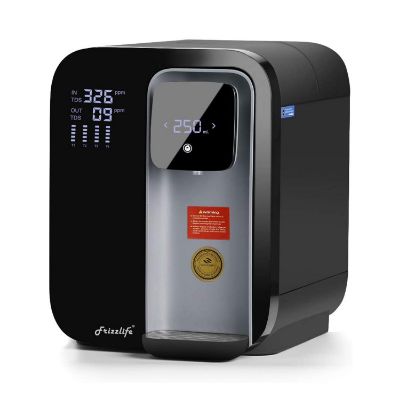
The Frizzlife Tankless RO System offers alkaline remineralization to restore essential minerals and avoid producing acidic water.
This compact, tankless system removes over 1,000 contaminants with its seven-stage filtration process and produces 600 gallons per day.
An LED display indicates the remaining life of filters; the plastic filter housings remain in place when filters are changed, creating a more eco-friendly product.
- Compact system takes up little space
- 600 gallons per day
- 1,000+ contaminants removed
- LED display indicates remaining filter life
- Does not work well with refrigerators
- When unused for a while, some customers report recontamination
- Some users report leakage
9. Home Master TMULTRA-ERP Ultra Under sink Reverse Osmosis System
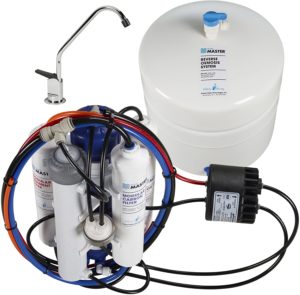
This reverse osmosis system made by Home Master provides a wonderful solution to your water filtration needs. Even the most health-conscious are impressed with the pure water that these Home Master units produce. It eliminates nearly 99 percent of iron and metals as well as sterilizing 99.9 percent of microorganisms in the water.
Home Master TMULTRA best under sink reverse osmosis system come with a permeate pump that increases system efficiency and reduces water waste by up to nearly 80 percent while at the same time increasing the water filtration production by approximately 50 percent. The permeate pump maximizes efficiency in places with limited water pressure.
The quality design of this pump is cutting-edge and excludes the common problems found in other typical reverse osmosis systems. The filters of the stages are simple to change and last a long time. You change them every 3,000 gallons or once a year, whichever comes first. Water flows through these Home Master systems twice as fast as other ones, so customers will like the pressure.
People find the installation of these Home Master water filters straightforward and taking up a small portion of a day.
- The filters are easy to change and last a long time (about every 3,000 gallons) and the systems has good water pressure
- All combined it reduces 98 percent of all chemicals, heavy metals, iron, sediment, bacteria, and additional contaminants
- The system’s design is cutting-edge, and as a result, it eliminated common design problems of other reverse osmosis filtration systems
- The system needs 115v of power for the lamp
- RO membranes also eliminate many helpful minerals
Conclusion
The Home Master TMULTRA-ERP reverse osmosis filtration system is an excellent high quality system that’s easy to maintain while eliminating microorganisms and metals.
10. iSpring RCC7AK 6-Stage High Capacity Reverse Osmosis System
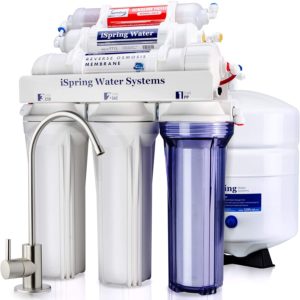
The iSpring RCC7AK reverse osmosis system is Alkaline Remineralization-Natural pH WQA (Water Quality Association) Gold Seal Certified. The reverse osmosis membrane not only eliminates pollutants but also many harmful minerals and will remove bacteria. This iSpring is a normal reverse osmosis system without a permeate pump.
Standard five stage systems produce water that is slightly acidic with an acid level of 7.0 or below as a result. The 6th stage alkaline remineralization filter that restores the healthy minerals and balances the alkalinity producing better-tasting water.
It’s certified to eliminate nearly 99.99 percent of more than 1,000 harmful contaminants and minerals that are found in well and municipal water. Therefore, it’s effective for both types of water sources with high mineral content.
All iSpring parts are manufactured to strictly comply with NSF/ANSI and FDA standards. Maintenance is low on this system, and the clear 1st stage housing makes inspecting your filter easy. It also comes with a nice faucet to install in your sink next to your normal tap water faucet.
Installation is straightforward and you can install this system yourself in a couple of hours. If you need support, iSpring help is just a phone call away. It comes with videos and clear instructions for easy installation. The system is a stunning European design with a brushed nickel faucet.
- You can easily install the filtration system yourself because it comes with good instructions and videos
- This system has the 6th stage Alkaline Remineralization filter that restores healthy minerals eliminated by other systems and balances the alkalinity for excellent tasting water
- The WQA tests iSpring products annually and the system is certified to remove 99.99 percent of over 1,000 unsafe contaminates
- Some users reported lower system efficiency and more water waste
What Is A Reverse Osmosis Filtration?
Reverse osmosis filtration systems work by forcing water molecules through an extremely fine membrane using water pressure. As the water passes through the screen, harmful contaminants are left behind. The purified water is then collected from the clean side of the membrane while the contaminants are flushed out of a drain.
Conventional reverse osmosis systems are comprised of a chlorine/sediment pre-filter, the reverse osmosis membrane, a carbon-activated filter and a storage tank.
These filtration systems remove inorganic material found in water which makes them a great option for places with brackish drinking water. This is especially true since this water contains dissolved minerals that are hard to eliminate using other processes.
There are six possible stages in these systems (not including the storage tank). Not every reverse osmosis system has all six stages.
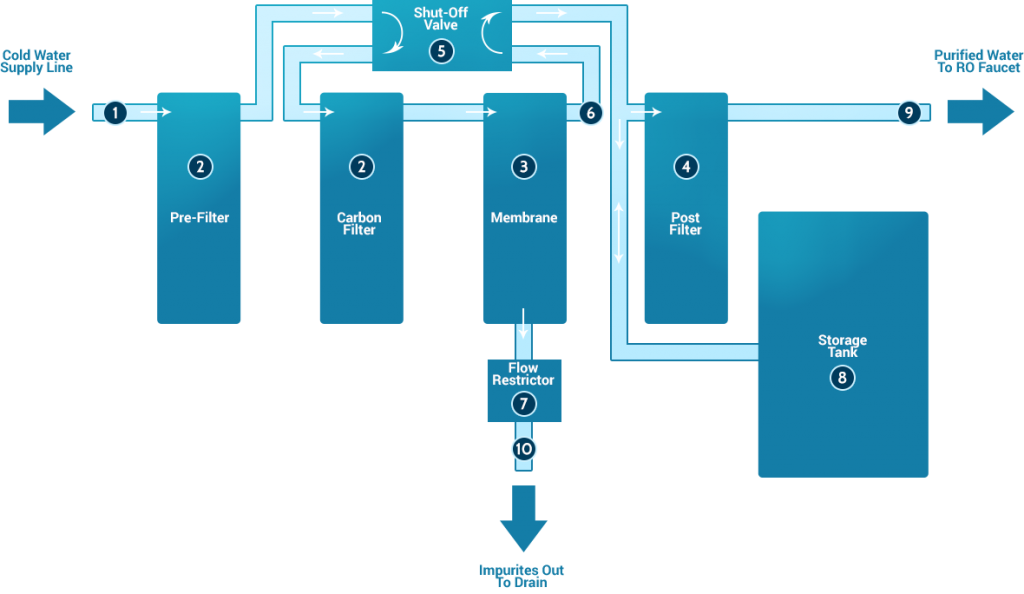
The Six Stages of Reverse Osmosis Filtration Process:
- 1st Stage– Also known as the sediment stage, this is the first stage that eliminates rust, rough particles, and sand
- 2nd Stage– The Carbon stage gets rid of chlorine and other harmful chemicals that would damage the TFC reverse osmosis membrane. Multiple carbon cycles may be required depending on the quality of the carbon and the contact time.
- 3rd Stage– This stage eliminates any dissolved solids and essentially anything bigger than a water molecule. This is when most of the purification process happens.
- 4th Stage– Here is the remineralization stage that remineralizes the water with magnesium and calcium to balance the acidity. Since water purified by reverse osmosis is slightly acidic and has the healthy minerals stripped away this part of the process makes the water healthier and improves the taste.
- Optional treatment stage or stages- Here is where reverse osmosis systems differ. Some use UV filters to kill microorganisms. There are also deionization/nitrate/arsenic/fluoride filters that can eliminate any trace amounts of hazardous contaminants left in the purified water.
- The Final Carbon stage- This filter is also called the “polishing” filter, and it eliminates any odors or tastes that the acidic reverse osmosis water has accumulated.
What To Look For in a Reverse Osmosis Water Filter
One of the first things to consider searching for reverse osmosis systems is the size of your home and family.
Large homes with large families may need a commercial grade system because the use more water. Smaller homes and families can get away with using a portable system or smaller permanent one.
Also, what are the plumbing requirements and how much space to you have available for the system. This two factors will really effect how many options you have. Smaller spaces may not accommodate standard-sized equipment.
Does the equipment need to be installed under the sink or can it be installed elsewhere with more space?
Another question to ponder is what type of water source do you have? Is it well water or city water?
Contaminants:
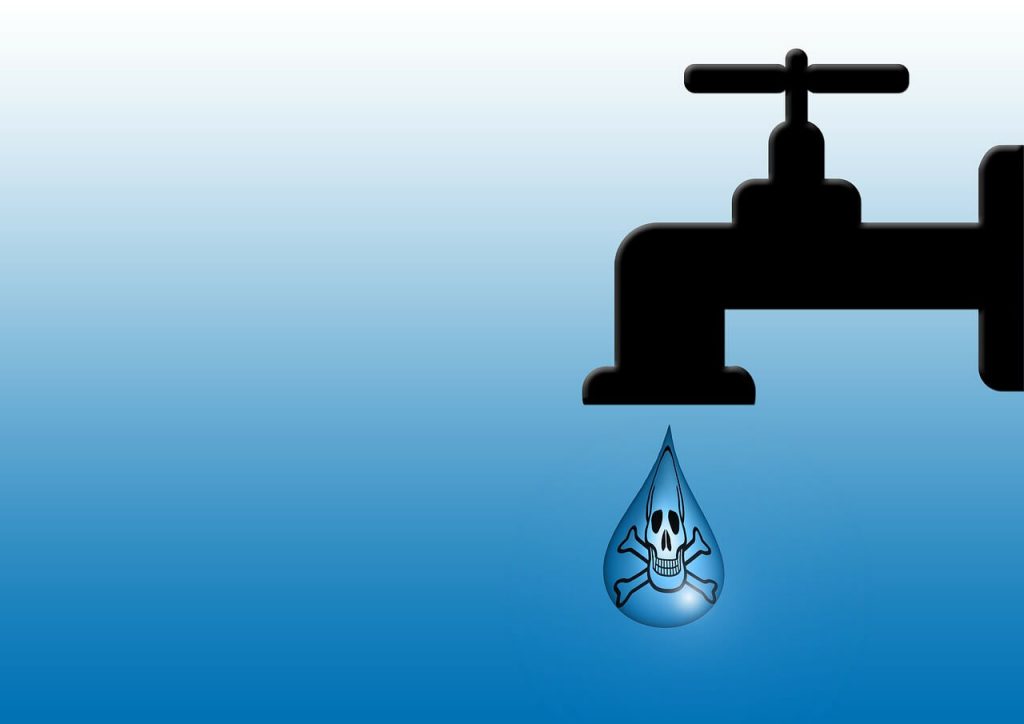
The Safe Drinking Water Act defines “contaminant” as any radiological, physical, biological, chemical or other matter in water. From this definition, you can see that contaminants are considered just about anything. It’s important to remember that that there are healthy “contaminants” in water as well, like minerals.
Is your water source brackish? Are you looking to eliminate more microorganisms? Are there specific contaminants that you’re looking to get rid of such as lead, chromium, rust or fluoride?? These are some questions to ask yourself before choosing the right reverse osmosis system for your needs.
All systems vary with the amounts and types of contaminants that they reduce or eliminate. Each home or area has problem contaminants specific to them.
Testing your water would be an excellent way to see just what is floating around in your drinking water. Different filters within these filtration systems target specific contaminants, as well.
Ro Filters Certification
Depending on where one resides, it’s a fact that there could be a high level of contaminates in the local tap water that you use for cooking or drinking. The exact nature of these contaminates will depend on your local or regional situation.
For example, in the American Midwest, there is a high amount of agriculture that takes place in many areas. Because of this, it’s not unusual to experience a high level of pesticides and herbicides in the local water supply. The reason is that rainfall and natural processes result in runoff of these chemical contaminates into ponds, rivers, and underground water channels.
Other areas of the country may have naturally occurring high levels of sediment or certain chemicals, organic, or inorganic substances. In addition to chemicals and minerals, there’s also a serious risk around the presence of bacteria, viruses, and other biological threats.
It’s worthwhile to review how reverse osmosis systems work so that there is clarity on how the filter works to treat water. The name comes from the fact that in this system the flow of water is reversed and flows from a concentrated solution to one that is more dilute.
And this flow of water happens through a membrane is where some of this filtering takes place. It’s important to note, however, that this membrane in this process can’t accomplish all the goals of a robust water filter.
Therefore, most reverse osmosis water filter systems incorporate additional stages of filters to do the additional work.
The most popular additional filter that is used in reverse osmosis systems is carbon filtration. This is especially effective at eliminating chloramines. Chloramines are disinfectants that are added to water supplies by municipalities and water utilities to protect public health by killing or inactivating harmful organisms.
There is a long list of things in water supplies that warrant the need for a reverse osmosis system. Whether it’s sediment, biological matter, chemicals, radionuclides, arsenic, asbestos, heavy metals, and many other contaminates, both residences and businesses clearly see the need for effective water filtration to produce healthy, safe, and good tasting water for their needs.
Read our recent guide on fluoride removal via reverse osmosis: Does Ro Remove Fluoride From Water?
Water Waste, Container Size & Filter Speed:
You should also consider water waste ratio, container size & filter speed.
Here are some additional considerations:
- Output of water / water pressure / gallons per day (GPD)
- Waste Water
- Tank Size
- Professional versus self-installation
- Remineralization
- Number of filtering stages
- Difficulty of installation
Along with those considerations are various features to think about with these particular filtration systems. They are:
- Compact equipment– Some models are built compact to take up less space. Compact equipment may be necessary in apartments and RVs.
- Post Carbon– This feature removes the taste and odor from water after the filtration process. These cartridges contain burnt coconut shells. That’s what gives the water a nice taste.
- Storage Tank– This is where the water is stored after filtration. They are most useful when there is no water or time to make filtered water and allows you to drink what’s in the tank until you can filter fresh water. However, since the filtered water contains no chlorine, it does not prevent bacteria from infecting the water in the storage tank. It’s a good idea to bleach the tank twice a year to disinfect it.
- Flow Control– This helps regulate the flow of water passing through the membrane to increase its lifetime.
- Ultraviolet– A UV feature helps keep bacteria out of your water after its filtrated. Its an alternative to disinfecting your storage tank twice a year. The UV filter is put into the system after the tank and prior to the faucet to eliminate any bacteria from the tank that have migrated towards the faucet.
Some other features include; twist off filters, air gap faucet, TDS meters, rejection of impurities, and shut off.
Reverse Osmosis Filter Installation
Reverse osmosis systems are a popular water filter type and are offered by many different manufacturers that may also have different models for purchase. Because of this popularity, these reverse osmosis systems have become extremely easy to install by most homeowners or business owners.
So, there’s no need to fear the installation process. It’s always helpful to be handy, have professional tools, and some specific plumbing knowledge to help the installation activities. But, in most cases, none of these should be necessary to successfully install one of these devices.
The first you always want to do in these situations is to thoroughly read the instructions that are provided by the manufacturer of your reverse osmosis system before you start the installation. You will find information here that is specific to the model and reflects the parts and accessories that come with it.
There may also be specific instructions on plumbing configurations, and you need to identify which one you have and what portion of the instructions apply to your situation.
Once you’ve reviewed the instructions carefully from beginning to end, it’s time to get started with the installation.
Here, we’ll provide a general overview of the stages involved in installation:
- Turn off the cold water shut-off valve. This is your first step to make sure that water doesn’t enter the process and where you are going to be doing your work
- Next, turn on the cold water at the faucet in your sink to confirm that there is no flow and that water is out of the system
- Remove the water line from the shut-off valve
- Then, use the adapter provided by your system to connect at the cold-water line to provide the feed water to your reverse osmosis system
- Turn the cold water back on at the shut-off valve
- Position your reverse osmosis system’s filter and reservoir tank in your under-sink cabinet space
- Set up the drain line from your system’s filter to the waste line with the included saddle mechanism. You will need to drill a hole into your existing waste line and install the saddle so that the reverse osmosis system can discard its normal amount of water here.
- Use an existing opening on your sink or drill an appropriate hole into your sink area to accommodate the new water faucet for the treated water. Carefully make this hole, if one doesn’t exist. Make sure you have the right tools, use safety glasses, and make sure you have the right tools and drill bits to get the job done right.
- Install the new faucet and under the sink make sure the water line goes to the output of your reverse osmosis system
- Also, connect your reservoir tank to the filter system
- That’s it, you are done!
Here’s an excellent video that illustrates this installation process well:
We recommend after installation that you clean up your work space, put away tools, and check for leaks at all adapters and joints that you’ve created. Then, run the system for about 1 to 2 gallons to make sure the filter is ready to do its job and any sediment or other impurities are out of the system.
At this point, you are ready for clean, healthy, and good tasting water from this day forward.
Reserve Osmosis System Maintenance
The beauty of reverse osmosis systems is that don’t require much maintenance to be performed. The main thing you will need to do is replace the filters at some interval and that depends on the level of usage in your home or office.
It’s basically a function of how many galls of water the system has treated until you will need to replace the filters to make sure the system functions at maximum intended performance.
Here is a general overview of the filter replacement process:
- Turn off the cold water shut-off valve
- Turn off the valve at the reservoir water tank
- Open the water faucet on the sink to clear out any water in the system and relieve the pressure
- Use your filter wrench to turn the filter to unscrew it from the system housing, start with the first stage first
- Once the first stage filter is clear of the housing, remove and discard the worn filter and insert a new one
- Hand tighten the filter back onto the housing and then finish the tightening with the filter wrench
- Repeat the same steps in 4-6 for each additional stages of filters being replaced
- Finally, open your faucet for 1-2 minutes to flush out an amount of water to be ready for clean pure water again
Again, please note that these are general instructions that will give you a good overview of the process involved in replacing filters on your reverse osmosis system.
You should follow the specific instructions that your manufacturer provides for your specific make and model of reverse osmosis filter.
Frequently Asked Questions About RO Systems
Reverse osmosis is a process where water is sent through a membrane and potentially additional filtering stages to treat it for safe consumption.
Yes, these systems are in wide use and have been found to be highly effective provide safe water for consumption.
Yes, one of the chief jobs of the system is to remove the almost all the minerals from your water. This is what you want, especially in locales that have water with high sediment and mineral levels.
Yes, reverse osmosis filters do an excellent job of removing chemicals, pesticides, herbicides, fuel additives, chloramines, and even biological threats like bacteria and viruses to make your water safe.
Yes, the system will filter out these items from your water, as well. Day in and day out, reverse osmosis water filters are providing gallons of filtered water for people around the world.
No, reverse osmosis systems generally work just by water pressure and being installed correctly into your water system. There are some systems that feature permeate pumps that are electrical and have the advantage of providing more gallons of water per day.
Quality reverse osmosis systems should last for many years with proper initial installation and occasional maintenance. Filters for the system will need to be replaced every 12 months, depending on use. A reasonable reverse osmosis system is in the $200-400 range and replacement filters are around $30-40 for yearly replacement filters and $20-90 for other filters that need to be replaced very 2-5 years.
Alternatives to RO Water Systems
There are a variety of water filtration solutions out there. One alternative is an alkaline water ionizer. This is an electrical appliance that works on the concept of electrolysis.
Other alternatives are ozone generators and whole house purification systems.
Final Words
These reverse osmosis filtration systems are the best on the market. Any of these reverse osmosis water filtration systems would be a great addition to your home.
They provide great tasting water that’s healthy for an economic price. You no longer have to worry about hauling cases of water home, plus these systems are better for the environment.
Yes, other filtration system exists, and they do a fine job, too. However, these systems eliminate the most contaminants.
They come with the best features to offer the best tasting, cleanest water. Since water is so vital to human health, it goes without saying that the purest water is the best.
See Also :

